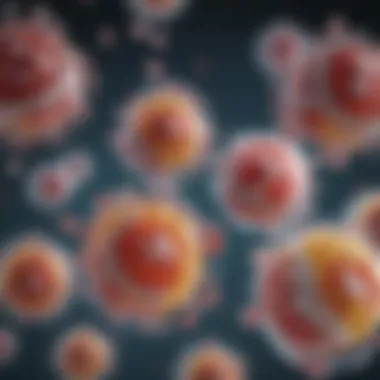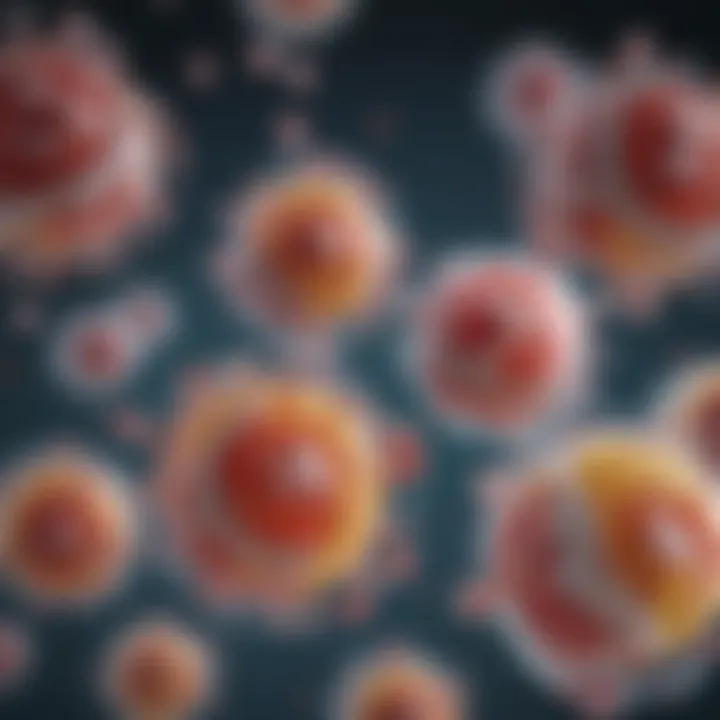Understanding Antibiotic Resistance in Bacteria


Intro
Antibiotic resistance in bacteria is a critical issue impacting public health globally. As antibiotics have been the cornerstone of bacterial infection treatment for decades, the growing prevalence of resistant strains threatens to undermine these medical advances. By understanding the mechanisms behind antibiotic resistance, we can begin to address this pressing issue.
This section will outline the key components of antibiotic resistance, including genetic factors, horizontal gene transfer, and misuse of antibiotics. Each aspect plays a pivotal role in how bacteria overcome the effects of antibiotics, leading to treatment failures and increased morbidity and mortality rates.
The relevance of this discussion extends beyond academic interests. It ties directly to real-world implications for healthcare systems, patient management, and public health policies. An informed approach to antibiotic use and resistance is essential for preserving the effectiveness of current treatments and minimizing future public health crises.
With these considerations in mind, let us delve deeper into understanding antibiotic resistance and its implications.
Foreword to Antibiotic Resistance
Antibiotic resistance has emerged as a pressing global health issue. It threatens to undermine decades of progress in curing bacterial infections, leading to increased morbidity and mortality. The importance of understanding antibiotic resistance cannot be understated, as it informs both clinical practices and public health policies. In this introduction, we will highlight several specific elements that define the significance of this topic.
Firstly, the rise of antibiotic resistance alters the landscape of treatment options available for healthcare providers. When bacteria develop resistance, standard therapeutic approaches may become ineffective, leading to prolonged illness and complications. Furthermore, this situation complicates the management of infections, making it a necessity for healthcare professionals to explore alternative treatments or combinations of drugs.
Secondly, the emergence of resistant strains poses a risk to vulnerable populations. Patients with weakened immune systems, such as those undergoing chemotherapy or surgery, face increased danger from infections that are harder to treat. The implications are serious, potentially leading to higher healthcare costs and longer hospital stays.
Lastly, public awareness regarding antibiotic resistance is key to combating this problem. Understanding how misuse and overuse of antibiotics contribute to resistance can lead to improved practices in both healthcare settings and everyday life, from patients adhering to prescribed treatments to agricultural use of antibiotics in livestock.
In summary, comprehending antibiotic resistance is vital, not only for the treatment of infections but also for the broader implications on public health and patient safety. This discussion sets the stage for a deeper examination of the mechanisms behind this phenomenon.
Definition of Antibiotic Resistance
Antibiotic resistance refers to the ability of bacteria to withstand the effects of drugs that once effectively killed them or inhibited their growth. This phenomenon occurs when bacteria mutate or acquire resistance genes, rendering antibiotics ineffective. The definition encapsulates the process by which these microorganisms evolve to evade the action of antimicrobial agents.
It is crucial to note that not all bacteria are resistant to all antibiotics. Resistance can be specific to certain drugs, a variable that complicates treatment choices. The capacity for bacteria to become resistant is a part of their natural adaptability, but human actions have significantly accelerated these processes, leading to challenges in managing infections.
Historical Context
The journey of antibiotics began in the early 20th century with the discovery of penicillin by Alexander Fleming in 1928. This breakthrough presented a powerful weapon against bacterial infections and revolutionized medicine. However, the widespread use of antibiotics began after World War II, igniting a golden age of antibiotic discovery and utilization.
As antibiotic usage surged, so did the emergence of resistance. The first documented case of antibiotic resistance occurred in the early 1940s, just as penicillin was being utilized in clinical practice. This initial development set a troubling precedent. Over the decades, healthcare providers saw various bacteria evolve resistance to nearly all available antibiotics.
By the turn of the 21st century, antibiotic resistance became recognized as a global crisis, prompting calls for immediate action from all levels of society. The historical context provides crucial insight into how practices within medicine and agriculture, alongside the natural capabilities of bacteria, have contributed to the current state of antibiotic resistance. Understanding this context is essential for developing effective strategies to address the problem.
Mechanisms of Resistance Development
Understanding mechanisms through which bacteria develop resistance is crucial. It helps in assessing how rapidly bacteria adapt in the presence of antibiotics. With insight into these mechanisms, researchers can formulate better strategies to combat resistance. Mechanisms such as genetic mutations, horizontal gene transfer, and biofilm formation all play an important role. Each mechanism has unique characteristics that deepen the understanding of resistance.
Genetic Mutations
Mutations are a driving force in how bacteria become resistant to antibiotics. These mutations can happen in many different ways.
Point mutations


Point mutations involve a change in a single nucleotide base in the bacterial DNA sequence. This simple alteration can lead to significant consequences, such as the production of proteins that antibiotics cannot bind to effectively. The key characteristic of point mutations is their ability to result in rapid changes. This makes them an effective mechanism for resistance development. While they are relatively simple changes, their impact can be substantial. A disadvantage, however, is that not all point mutations confer resistance; some might have no effect on antibiotic susceptibility.
Insertion or deletion mutations
Insertion or deletion mutations involve adding or removing nucleotide bases in the DNA. This can result in a shift in the reading frame of genes, potentially rendering important proteins nonfunctional. The unique feature of these mutations is their capacity to produce larger-scale changes to genetic information. These alterations can cultivate significant pathways to resistance. However, they can also be detrimental to the organism by disrupting important functions.
Selection pressure
Selection pressure refers to environmental factors that favor the survival of resistant bacteria over susceptible ones. For example, the presence of antibiotics in a clinical or agricultural setting creates pressure for bacteria to adapt. This mechanism is particularly significant because it highlights the role of human actions in encouraging resistance. Its unique feature lies in its capacity to create a breeding ground for resistant strains, which can lead to widespread issues. The downside is that addressing selection pressure requires broad changes in practices rather than individual efforts.
Horizontal Gene Transfer
Horizontal gene transfer allows bacteria to share genetic material freely, enabling rapid adoption of resistance traits.
Transformation
Transformation is the uptake of free DNA from the environment by competent bacteria. This process can lead to the acquisition of antibiotic resistance genes from dead bacterial cells. The key characteristic of transformation is its capacity for genetic exchange without direct contact between bacteria. This capability makes it especially beneficial for rapid adaptation. However, transformation is limited to species that can naturally take up DNA, reducing its applicability in some contexts.
Transduction
Transduction involves the transfer of DNA from one bacterium to another via bacteriophages, which are viruses that infect bacteria. This process can facilitate the spread of resistance genes among different bacterial species. A significant aspect of transduction is its ability to bridge genetic material across various bacteria. However, it is reliant on specific interactions between viruses and bacterial cells, which may limit its effectiveness in certain situations.
Conjugation
Conjugation is a mechanism where two bacteria form a physical connection, allowing for the direct transfer of DNA. This often includes plasmids that carry resistance genes. The characteristic strength of conjugation lies in its efficiency and speed, enabling rapid sharing of traits. Nonetheless, it requires close proximity between bacteria, which can limit its reach in larger environments.
Plasmids and Resistance Genes
Plasmids are small circular pieces of DNA that can replicate independently of the bacterial chromosome. They often carry one or more resistance genes, enabling bacteria to withstand antibiotic treatment. The ability to transfer plasmids between bacteria makes them a significant vector for resistance. Their presence in various bacteria demonstrates how resistance can spread quickly in microbial communities.
Biofilm Formation
Bacteria can form biofilms, which are clusters of bacteria that stick to surfaces and to each other. These biofilms can create barriers, preventing antibiotics from reaching the cells within. The biofilm structure contributes to increased tolerance to antibiotics and makes treatment more complex. Once formed, biofilms can be very difficult to eliminate, leading to persistent infections.
Efflux Pumps
Efflux pumps are protein complexes that bacteria use to expel antibiotics from their cells. This mechanism reduces the effective concentration of antibiotics inside the bacterial cell. Efflux pumps can be highly specific or can work to expel a range of substances, including various antibiotics. They contribute significantly to the challenge of treating bacterial infections, as their presence often leads to multidrug resistance.
Contributing Factors to Resistance
Antibiotic resistance is influenced by a myriad of factors. Understanding these contributors is vital for developing effective solutions. The overuse and misuse of antibiotics in medicine and agriculture play crucial roles in exacerbating this issue. Also, factors like incomplete treatment courses and insufficient infection control practices further facilitate the evolution of resistant bacteria. Each of these elements contributes not only to individual health risks but also to a broader public health challenge.
Overuse of Antibiotics
The overuse of antibiotics is a leading driver of resistance. In many countries, antibiotics are excessively prescribed for conditions where they are not necessary, such as viral infections. This practice creates an environment where bacteria can adapt and develop resistance to these drugs. According to a report from the World Health Organization, inappropriate prescriptions significantly raise the chances of developing antibiotic-resistant infections.
Patient pressure can also be a contributing factor. Many patients expect antibiotics for ailments that do not require these medications, influencing healthcare providers to prescribe them unnecessarily. This cycle leads to a higher prevalence of resistant bacteria in communities and can also complicate the treatment of infections.


Incomplete Treatment Courses
Incomplete treatment courses present another significant problem. When patients do not finish their prescribed antibiotic regimens, surviving bacteria can potentially develop resistance. This occurs because the stronger bacteria are usually killed off first. If treatment is stopped prematurely, weaker ones might not be eliminated, allowing them to evolve into more resistant strains.
Some patients may stop taking antibiotics due to side effects or a perceived lack of effectiveness. This behavior can create a pool of resistant bacteria that can spread, leading to infections that are much harder to treat. Ensuring that patients understand the importance of completing their antibiotic course is critical.
Use in Agriculture
The use of antibiotics in agriculture is a controversial and significant contributor to resistance. Farmers often administer these drugs to livestock to promote growth and prevent disease. According to data, about 70% of the antibiotics sold in the United States are used in animals, which raises critical concerns about human health. Bacteria in these animals can develop resistance and eventually transfer to humans through the food supply.
Regulatory bodies are beginning to take action by implementing guidelines aimed at reducing the use of antibiotics in agriculture. However, this remains a complex issue due to the economic pressures within the farming industry and the necessity of managing animal health.
Infection Control Practices
Insufficient infection control practices in healthcare settings can also contribute to the spread of antibiotic resistance. Hospitals are environments where resistant bacteria can easily spread. Poor hygienic conditions, inadequate sterilization of medical equipment, and lack of proper protocols for antibiotic use can exacerbate the situation.
Effective infection control measures are essential for preventing the transmission of resistant bacteria. Hand hygiene, the use of personal protective equipment, and meticulous cleaning protocols can significantly reduce the risk of spreading infections. When healthcare facilities ensure stringent infection control practices, they can help safeguard public health.
Without addressing the contributing factors to antibiotic resistance, efforts to mitigate this crisis may be in vain.
Impact of Antibiotic Resistance
Antibiotic resistance is a matter of great concern in today’s healthcare landscape. The rise of resistant bacteria affects not only individual patients but also the overall healthcare system. Understanding its impacts is crucial for developing effective strategies to combat this issue. The consequences of antibiotic resistance extend into public health, economic sectors, and medical procedures, all of which require thorough exploration.
Public Health Implications
Antibiotic resistance poses serious risks to public health. When bacteria become resistant to commonly used antibiotics, treating infections becomes challenging. Routine surgeries and procedures that depend on effective antibiotics for infection prevention face increased risks. Patients with weakened immune systems are disproportionately affected, leading to higher morbidity and mortality rates.
The World Health Organization has classified some bacterial infections as high priority pathogens due to their resistance, such as Methicillin-resistant Staphylococcus aureus (MRSA) and multi-drug resistant tuberculosis. These infections can spread quickly in community and hospital settings, contributing to outbreaks that can overwhelm healthcare systems. Preventing such occurrences is essential for maintaining public health safety.
"Antibiotic-resistant infections significantly complicate treatment options, leading to prolonged hospital stays and increased healthcare costs."
Economic Consequences
The economic impact of antibiotic resistance is substantial. Healthcare costs increase due to longer hospital stays, repeated treatments, and more expensive medications needed to treat resistant infections. A study by the Centers for Disease Control and Prevention highlights that antibiotic resistance contributes to over $20 billion in excess direct healthcare costs annually in the United States alone.
Moreover, there are also broader socioeconomic impacts. When patients become seriously ill, their ability to work diminishes, leading to loss of income. This situation creates a ripple effect that strains national economies. Also, affected families may face catastrophic out-of-pocket expenses, deepening poverty levels and widening health disparities, particularly in low-income regions.
Impact on Medical Procedures
Medical procedures often depend on effective antibiotics to minimize infection risks. Surgeries, chemotherapy, and organ transplants become more hazardous in an environment where antibiotics are losing their effectiveness against common pathogens. This can lead to a reevaluation of the risk versus benefit of certain interventions, affecting patient outcomes.
For instance, without reliable antibacterial prophylaxis, elective surgeries may be postponed, leading to delays in needed care. This situation not only affects individual patients but also strains healthcare resources and personnel time. As antibiotic resistance continues to escalate, the principles of medical practice may need to adjust entirely, which could inhibit advancements in healthcare.
In summary, the impact of antibiotic resistance touches multiple facets of society. It is crucial to address this challenge through education, improved prescribing practices, and ongoing research to find new treatment avenues. Only by operating at all these levels can we hope to mitigate the dire consequences presented by antibiotic resistance.
Strategies to Combat Resistance


Antibiotic resistance presents a major challenge to modern medicine. It threatens the effectiveness of treatments available for bacterial infections. Therefore, exploring strategies to combat resistance becomes critical. This section addresses various approaches and considerations essential to mitigating the rise of resistant bacteria. It focuses on prudent antibiotic use, the development of new antibiotics, vaccine advancement, and effective surveillance and monitoring practices.
Prudent Antibiotic Use
One of the most effective strategies to combat antibiotic resistance is practicing prudent antibiotic use. It is essential to ensure that antibiotics are prescribed only when necessary. Educating patients and healthcare providers about the proper use of antibiotics is vital. There are several key elements to this practice:
- Awareness of the signs and symptoms of bacterial infections versus viral infections. Antibiotics are ineffective against viruses.
- Completing prescribed courses of antibiotics to prevent incomplete treatment, which can allow resistant bacteria to thrive.
- Avoiding self-medication with antibiotics. This practice can lead to inappropriate use and increased resistance.
Implementing these measures can significantly reduce unnecessary consumption of antibiotics, thereby slowing down the development of resistance.
Development of New Antibiotics
The pace of discovering new antibiotics has lagged behind the growth of resistant bacteria. One strategy is stimulating research and investment in developing new antibiotics. This involves:
- Funding for research initiatives focusing on novel antibiotic classes.
- Encouraging partnerships between pharmaceutical companies and academic institutions to innovate new drugs.
- Implementing regulatory measures that incentivize antibiotic research and development.
Such strategies will contribute significantly to the arsenal of effective antibiotics available and help counteract resistance.
Vaccine Development
Vaccines represent another promising strategy to combat antibiotic resistance. They can reduce the need for antibiotic use by preventing infections. For example, robust vaccines against diseases like pneumonia, meningitis, and influenza decrease the incidence of bacterial infections. Considerations in vaccine development include:
- Investing in research to create vaccines for bacteria that commonly lead to resistance.
- Focusing on global immunization programs to increase vaccination rates in under-vaccinated populations.
- Educating the public on the benefits of vaccination to foster community support.
These measures can ultimately lead to a decrease in antibiotic consumption and therefore reduce resistance.
Surveillance and Monitoring
Effective surveillance and monitoring of antibiotic use and resistance patterns are essential for combating antibiotic resistance. This involves:
- Regularly collecting data on antibiotic prescriptions and resistance rates at local, national, and global levels.
- Analyzing trends to identify regions with rising resistance patterns and tailoring intervention efforts accordingly.
- Implementing educational programs for healthcare providers about local resistance patterns.
By integrating these monitoring strategies, health authorities can make informed decisions about antibiotic use policies and control efforts.
"Fighting antibiotic resistance requires a multi-faceted approach that incorporates prudent use, research, vaccine development, and monitoring."
Epilogue
The issue of antibiotic resistance is multifaceted and has far-reaching implications in the realm of public health and medical practices. Understanding this topic is crucial for several reasons. First, it encapsulates the urgency to address bacterial infections that are becoming increasingly difficult to treat. Antibiotic resistance contributes significantly to morbidity and mortality, needing immediate action from healthcare professionals, researchers, and policymakers.
Summary of Key Points
The discussion on antibiotic resistance outlined several key aspects:
- Definition and Mechanisms: Antibiotic resistance arises through genetic mutations and horizontal gene transfer. Understanding these mechanisms can help in developing better antibiotic therapies.
- Contributing Factors: The misuse and overuse of antibiotics across various sectors, especially in agriculture, exacerbates this problem. This includes practices such as not completing prescribed courses of antibiotics.
- Impact on Society: The societal implications of antibiotic resistance not only threaten public health but also create significant economic burdens. More resources will need to be allocated to develop new treatments and manage resistant infections.
- Strategies to Mitigate: Implementing prudent antibiotic use, boosting vaccine development, and enhancing surveillance and monitoring could play vital roles in addressing this issue.
Future Directions in Research
Future research on antibiotic resistance should focus on several key areas:
- Novel Therapies: Investigation into new classes of antibiotics and alternative strategies, like bacteriophage therapy.
- Genomic Studies: Enhanced understanding of the genetic basis for resistance can inform public health strategies. Genomic innovations could lead to targeted interventions that minimize misuse.
- Public Awareness Campaigns: Creating educational programs to raise awareness about the responsible use of antibiotics. Educating the public on the dangers of self-medication and antibiotic misuse is essential.
- Global Coordination: Collaborative international efforts are needed to monitor resistance trends and share successful strategies.
The growing threat of antibiotic resistance necessitates a comprehensive and ongoing commitment to research and education. It is imperative to recognize the critical nature of this challenge to safeguard public health now and in the future.















